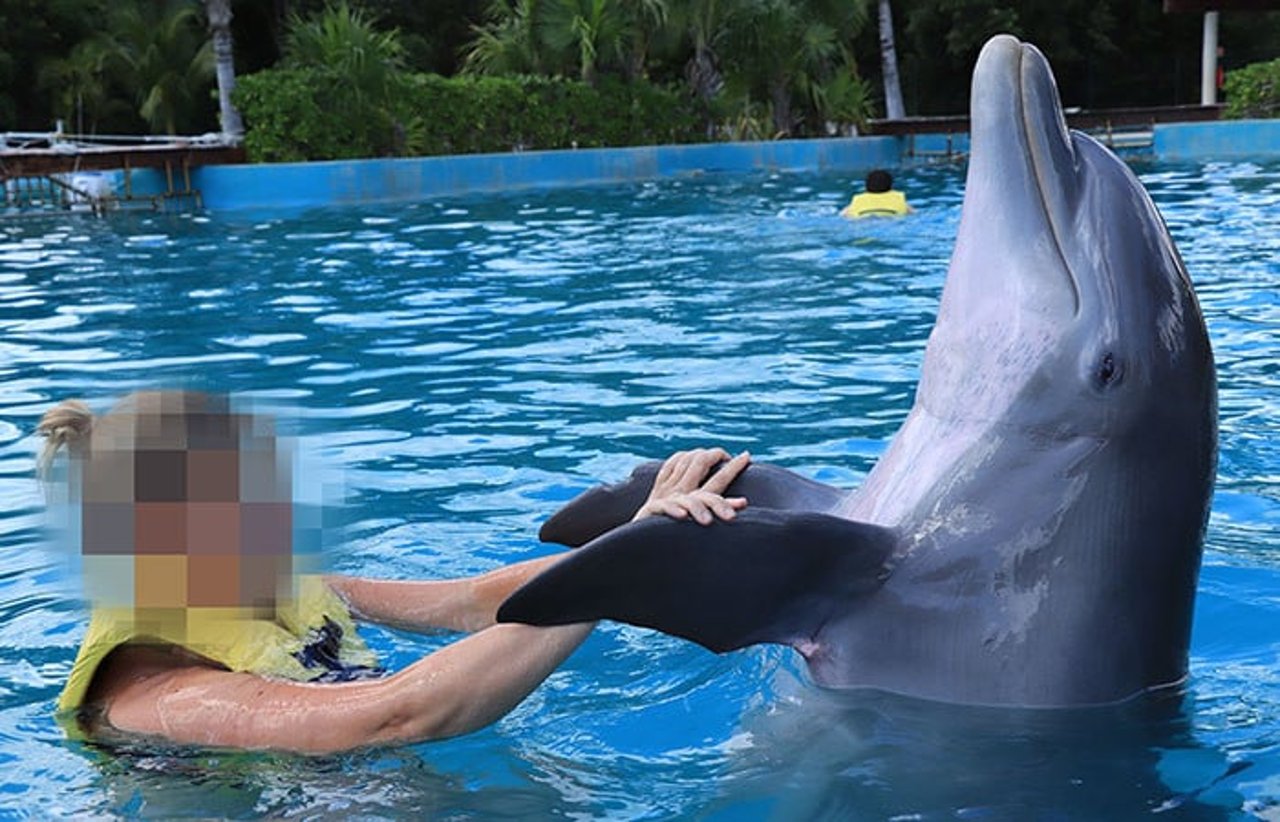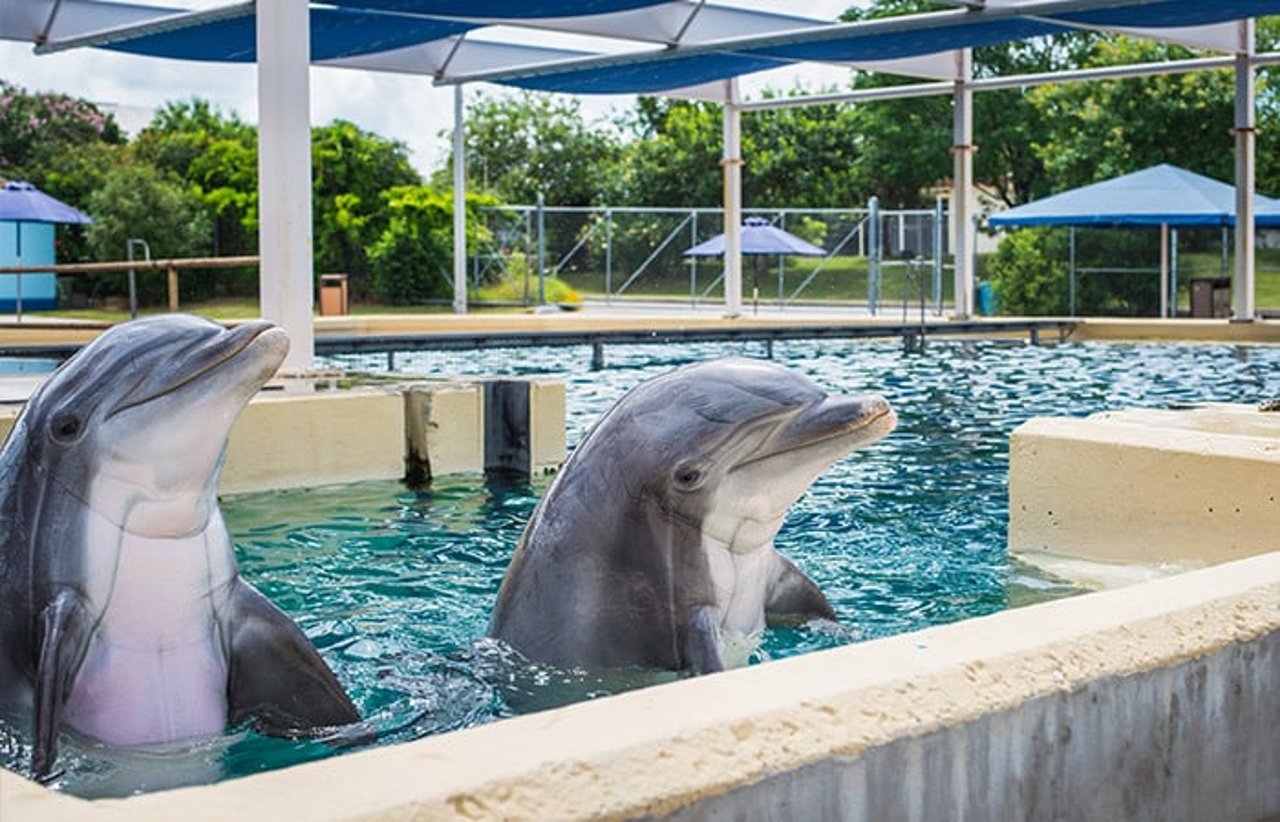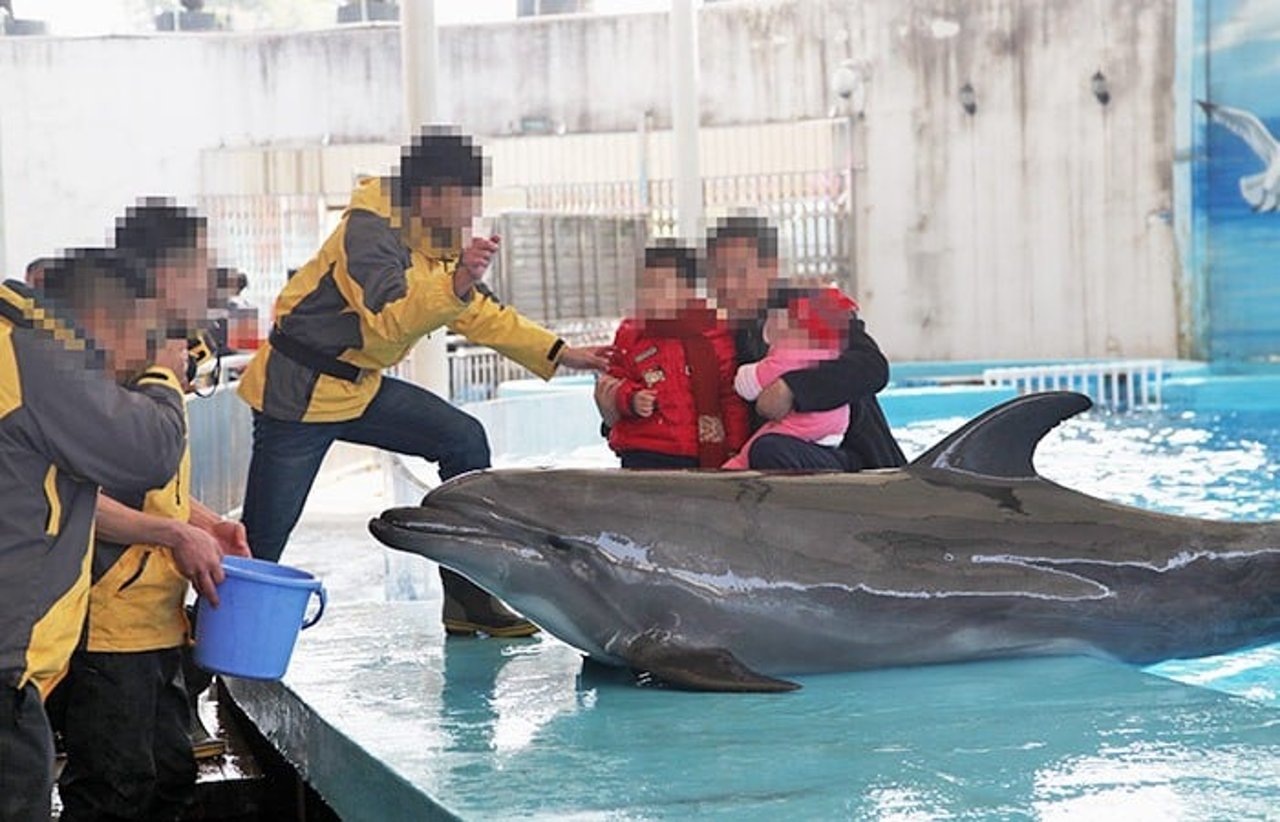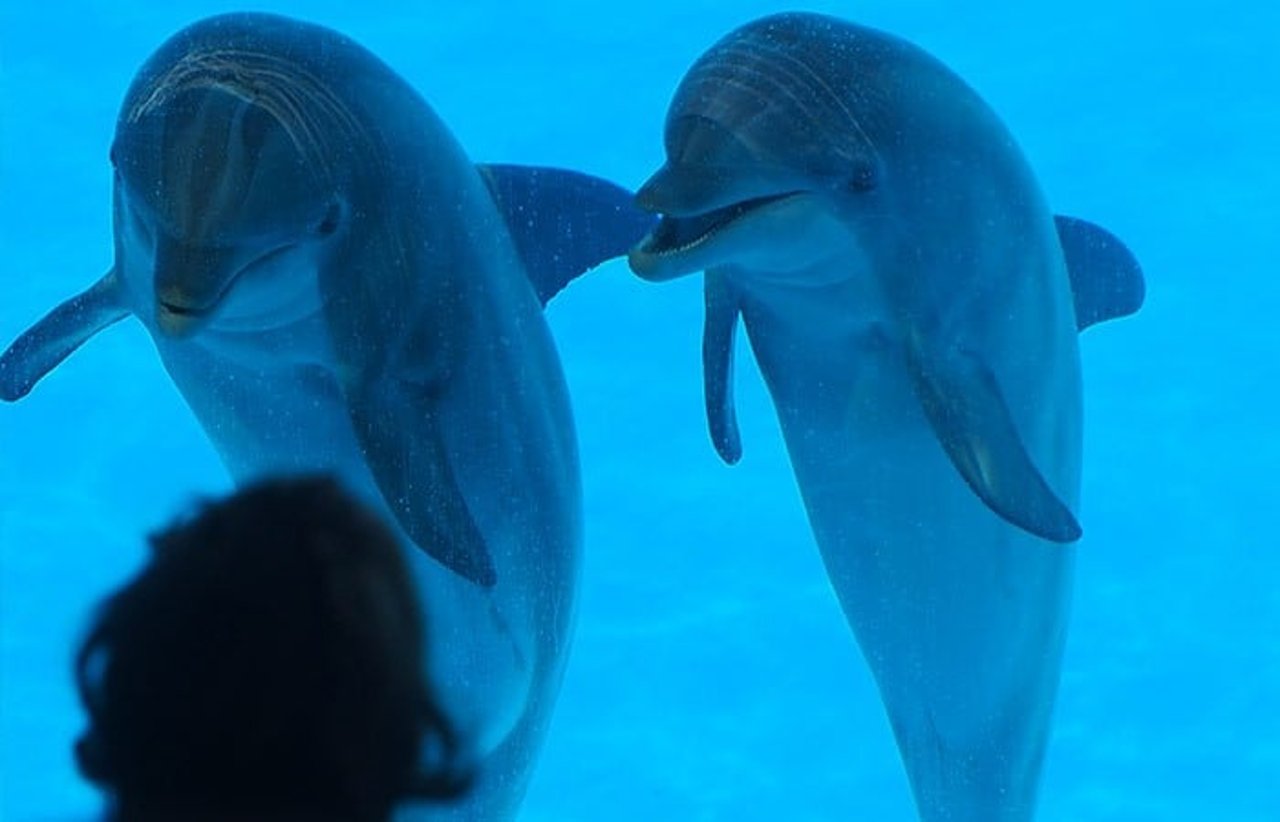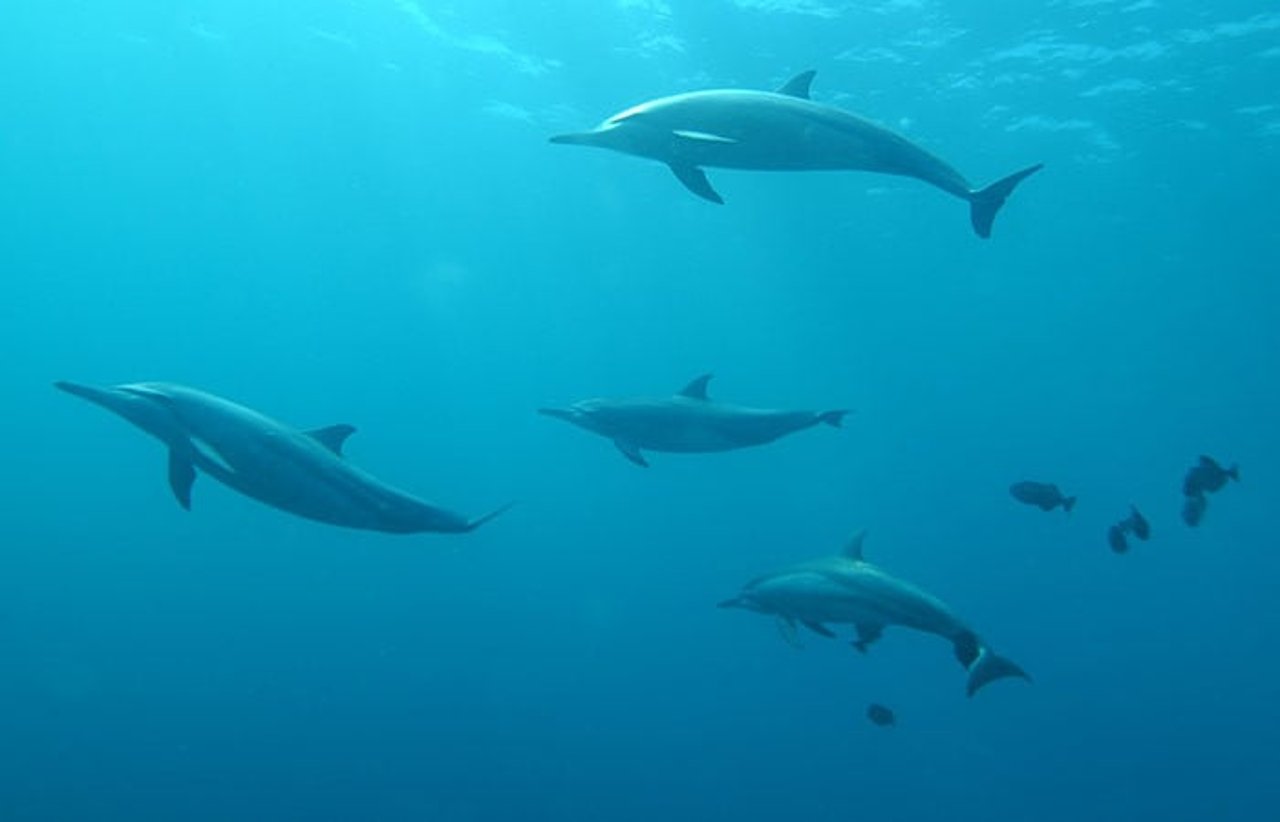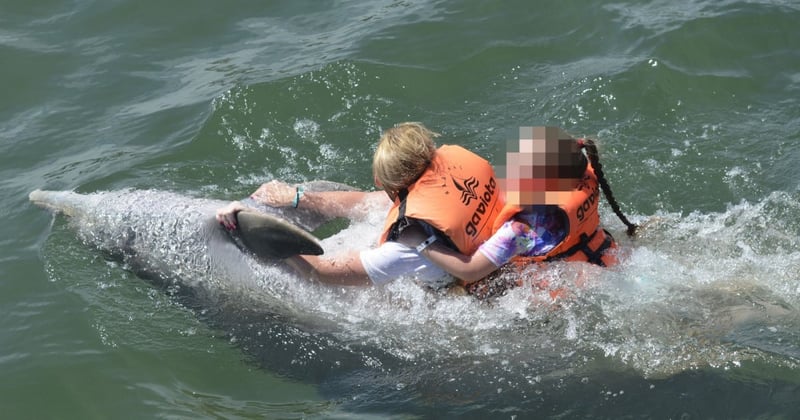
Swim with dolphin experiences are not safe for you, your family, or for dolphins. Find out why.
Who doesn’t love a well-deserved vacation, spending quality time with family on the shores of a sunny coast? We do! The excitement and anticipation always ramp up when you’re browsing sites looking for the best, well-reviewed activities to book. But many of the animal entertainment experiences you will find are making wild animals suffer as tourist attractions. Whether you’re planning activities for a winter getaway, a fun-filled spring break, or an unforgettable summer, there are definitely activities you should avoid.
Despite the ubiquitous images of happy-looking dolphins and laughing children you’ve probably seen before, don’t be fooled by their smiles. Dolphins living in captivity are suffering silently for the sake of entertainment. If you’re planning to swim with dolphins on your vacation, here are five reasons why you should reconsider.
A tourist interacting and swimming with a dolphin.
1. Dolphins aren’t smiling. It’s just the shape of their face.
Dolphins may look like they’re happy to us, but their “smiles” are illusions. When humans smile, we signal happiness, contentment, and enjoyment to each other. But a dolphin’s toothy grin is not an expression of joy–this is simply an anatomical anomaly. Since dolphins always appear happy to us, the dolphin entertainment industry takes advantage of this misinterpretation to cover up their cruelty. The truth is dolphins smile even when they’re dead.
Dolphin entertainment, like swimming with dolphin experiences, forces these curious creatures to live in captive environments and exhibit highly unnatural behaviors, such as “waving,” “tail walking,” and “speaking” by withholding food. Combined with consistent physical interaction with humans, noisy crowds, blaring music, and concrete tanks that affect echolocation, captive dolphins are under an incredible amount of stress. This stress leads dolphins to float lifelessly, swim in circles, and gnaw on the concrete walls or gates of their tanks. Don’t be fooled by their smiles. Dolphins aren’t happy to entertain you.
Dolphins at an entertainment venue.
2. A life in captivity is no life at all.
For a wild, energetic dolphin who can swim up to 40 miles a day, any captive facility, tank, or enclosure is too small. The tanks that they are confined in are hundreds of thousands of times smaller than their natural home. Not only is this space uncomfortable–it can be harmful. In hot weather, dolphins are unable to swim to deeper, cooler waters to escape the heat, and the sun’s rays can cause blistering on their sensitive skin.
A family swimming with a beached dolphin at a venue.
3. Swimming with dolphins is not safe for your family or the dolphins.
Again, don’t be fooled by their smiles–dolphins are wild animals. You wouldn’t dream of putting your children in a cage with a lion or tiger. Despite what dolphinaria may have you believe, dolphins are apex ocean predators, capable of even killing sharks, and should be treated as such. Dolphins can be aggressive to people, other dolphins, or even self-harm. While the majority of dolphins in the US are bred in captivity, they are not domesticated animals. Pushing people into deeper water, head-jerking, and biting causing broken bones, skin abrasions, and other injuries have all been reported with direct contact interactions with dolphins. Injuries–many inflicted by captive-bred dolphins–occur more commonly in interactive programs than is reported or widely known. In fact, a sample disclaimer from SeaWorld’s Discovery Cove states in part:
“You are agreeing to let your minor child engage in a potentially dangerous activity. You are agreeing that, even if the released parties use reasonable care in providing this activity, there is a chance your child may be seriously injured or killed by participating in this activity because there are certain dangers inherent in the activity which cannot be avoided or eliminated.”
In addition, chlorine is normally added to captive dolphin pools to keep bacteria levels safe for humans. But dolphins, who remain in that water all day and night, often develop chemical burns to their skin and eyes, which can blind them. Even with such a dangerous precaution, disease transmission between humans and dolphins can still occur.
Two dolphins confined to a pool in captivity.
4. Captive dolphins are bred for a lifetime of confinement.
Let’s face facts: dolphins bred in captivity at venues around the world will most likely never be released into the wild. Captive breeding programs tout themselves as “conservation” programs when, in reality, they serve merely to replenish the supply of dolphins for captive exhibits, including interactive programs. Venues that promote breeding as conservation often put less than 1 percent of their revenue into protecting wild populations. Bottlenose dolphins, who are the most-used species of dolphins for swim-with interactions, are not endangered and, therefore, should not be bred in captivity.
Furthermore, calves are separated from their mothers before many essential life lessons can be taught. For instance, many calves are removed from their mothers before they learn how to properly nurse and thus are less able (or in some cases completely unable to nurse their own offspring, leading to an increase in infant mortality). By breaking these natural bonds prematurely, captive facilities deprive these dolphins of essential life skills and are thus worthless for conservation breeding efforts.
5. Dolphin entertainment destroys dolphin families.
Dolphins around the world are often traded from venue to venue in efforts to breed the animals and prevent inbreeding, as well as to ensure that young calves do not disrupt the entertainment shows.
This consistent transport of animals, which increases the likelihood of death by sixfold, from the pods they know to pods they don’t leave much room for tank aggression. Due to these artificial pods, who are forced to interact unlike they would in the wild, severe tank aggression is almost certain. Unlike their wild counterparts, who can choose who to interact with, dolphins in tanks are forced to interact with others who may have different dialects or whom they simply don’t like. Signs of aggression in dolphin venues include jaw-popping, ramming into other dolphins with their rostrums, or biting, leaving rake marks.
Unsurprisingly, onlookers in facilities around the world have recorded multiple incidents of dolphins jumping onto tank slide-outs to escape an aggressive tankmate.
How can my family still learn about dolphins without supporting ‘swim with dolphins’ programs?
The best way to commune with dolphins is from the deck of a wild dolphin watch operation that follows a responsible code of conduct or, better yet, from shore, where you can be sure that you’re not harming them and they can’t harm you.
An industry based on lies
The multibillion-dollar captive dolphin industry wants you to think dolphins enjoy their confinement. They rely on a quirk of nature–the shape of a dolphin’s face–and years of misinformation. Captive dolphins are living miserable lives in the name of profit, and by refusing to support swim with dolphin experiences, you can help put an end to their suffering.
In July 2019, we successfully pushed a travel industry giant, Virgin Holidays, to end dolphin entertainment ticket sales. After talks with World Animal Protection, TripAdvisor committed to ending the ticket sales of venues that breed, import, or capture dolphins. Airbnb implemented an animal welfare policy that bans venues that have marine mammals in captivity. And in 2021, we moved Expedia to stop selling tickets to captive dolphin shows. But there is more work to be done.
Groupon, the major discount and travel company, known for its discounted deals to restaurants, gyms, and hotels, is selling deals for businesses that exploit wild animals like dolphins for tourist entertainment and profit. For example, in the past several years, Groupon has sold deals for SeaWorld, where dolphins, orcas, and other marine mammals are forced to perform tricks and shows under unnatural and cruel conditions.
Help us stop Groupon from profiting from dolphin suffering.
